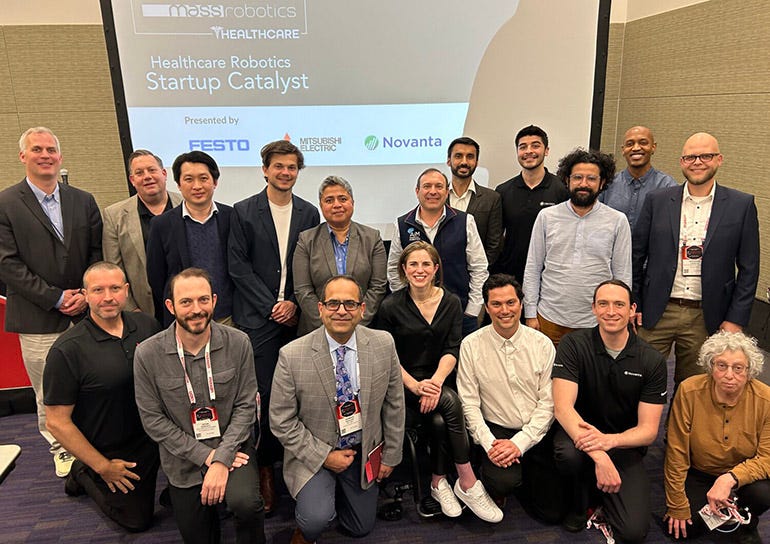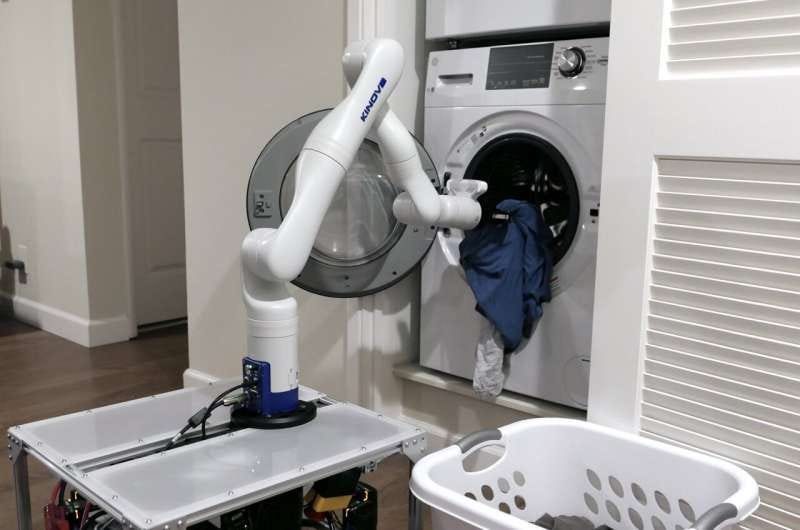From Oceangate to Jeju Air: There Are Lessons For The Robotics Industry
From robot safety to public trust, having a culture of safety and ethical operations will ensure the Robot Industry limits any future tragedies that involve robots
Aaron’s Thoughts On The Week
“Airline Regulations are written in blood” - Airline Industry Saying
Recently, the Jeju Air crash and the Oceangate submersible disaster have captured global attention for their devastating outcomes. These tragedies highlight critical lessons about the importance of adhering to safety standards and regulatory compliance—lessons that the rapidly evolving robotics industry must heed to prevent similar catastrophic failures.
The Jeju Air Crash: A Lesson in Operational Standards
The crash of Jeju Air Flight 2216 on December 29, 2024, highlights several potential violations of international aviation standards and regulations, raising critical questions about safety protocols and infrastructure. The Boeing 737-800 encountered a bird strike while approaching Muan International Airport, leading to a mayday declaration and a failed landing gear deployment. The aircraft belly-landed, overran the shortened runway, and collided with a concrete barrier supporting a navigation antenna. This catastrophic incident claimed 179 lives, marking the deadliest crash involving a South Korean airliner since 1997.
Key Issues of Concern:
Bird Strike Mitigation: Muan International Airport reported the highest bird strike rate among South Korea’s regional airports. Implementation was delayed despite prior environmental assessments recommending deterrent measures (e.g., sound cannons, and lasers). On the crash day, only one of the four required personnel was on duty to manage bird hazards, potentially violating ICAO guidelines for wildlife risk management.
Runway Safety and Infrastructure: The runway’s shortened operational length (2,500 meters) due to construction raised concerns, though officials denied its impact on the crash. Crucially, a solid concrete barrier within 202 meters of the runway’s end appears to breach international safety standards, mandating clear, frangible zones in overrun areas. Experts criticized this structure for exacerbating the crash’s severity, as it turned a survivable belly landing into a fatal event.
Aircraft Maintenance and Disclosure: Jeju Air’s initial omission of a 2021 tail strike incident involving the same aircraft and subsequent regulatory fine for safety violations raises questions about transparency and adherence to maintenance and safety reporting standards.
Oceangate Disaster: When Innovation Outpaces Regulation
The Oceangate submersible disaster demonstrated the dangers of bypassing regulatory scrutiny in the pursuit of innovation. Oceangate’s Titan submersible, designed for deep-sea exploration, operated outside the purview of conventional safety certifications. The company’s decision to forego third-party verification in favor of internal evaluations proved fatal. This tragedy highlights a fundamental truth: innovation cannot come at the expense of safety.
James Cameron had some words about Titan and how the submersable industry knew that it was only a matter of time. Watch the full interview here.
…it's certainly a tragedy for the people aboard and especially for the families….I think it's important for people to understand…we've had 50 or 60 years of flawless operation of deep submersibles and I'm in that world…and I think I understand the safety protocols and the safety mentality very very well and these guys broke the rules it's that simple and so this is an anomaly right and it should be thought of as an anomaly not the standard I think you know I've done all these films from the deep ocean and it sort of suits the film to make it seem exotic and dangerous and you know going to another planet and that sort of thing the truth is it's really done by a set of standards that are so rigorous it's very very safe it's my understanding and I think you've just confirmed this that in this immersible community that culture of safety is it's critical I mean not only to Innovation but to Commercial Success…
The Robotics Industry at a Crossroads
The robotics industry is undergoing exponential growth, with applications spanning healthcare, manufacturing, autonomous vehicles, and more. As companies race to push the boundaries of what robotics can achieve, they face a pivotal question: How do we balance innovation with the need to uphold rigorous safety and ethical standards?
1. Establishing Comprehensive Standards
Robotics systems, much like aircraft or submersibles, interact with complex environments and have the potential to impact human lives. Standards such as ISO 13482 (safety requirements for personal care robots) and ISO 10218 (safety standards for industrial robots) provide foundational guidelines. However, these standards must evolve alongside technological advancements.
The Jeju Air and Oceangate cases reveal the dangers of underestimating the value of these frameworks. Adhering to established standards should not be seen as a bureaucratic hurdle but as a fundamental requirement to ensure safety and reliability.
2. Third-Party Verification and Certification
One of the most glaring issues in the Oceangate tragedy was the lack of third-party certification. For robotics, independent assessments should be mandatory for systems that operate in high-stakes environments, such as autonomous vehicles or surgical robots. Certification bodies like UL and TUV Rheinland and Standards organizations like ISO and ASTM offer frameworks for evaluating robotic systems, and their involvement should be a prerequisite for deployment.
3. Building a Culture of Accountability
The Oceangate tragedy highlighted the importance of accountability at every organizational level. Similarly, robotics companies must foster a culture where safety is a shared responsibility. Engineers, managers, salespeople, marketers, and executives alike should prioritize transparency and proactively address potential risks.
4. Learning from Failures
Both tragedies are stark reminders of the importance of learning from past mistakes. The aviation industry has long relied on incident reporting and root cause analysis to enhance safety. The robotics industry can adopt similar practices by establishing centralized databases for reporting failures and sharing lessons learned across the sector.
The Human Factor
While technology is central to robotics, human oversight remains critical. The Jeju Air crash and Oceangate disaster both involved decision-making failures. In robotics, human operators, engineers, and regulators must work collaboratively to identify and mitigate risks. Training programs should emphasize technical expertise, ethical considerations, and the potential consequences of neglecting standards.
The Role of Regulation
Governments and regulatory bodies are crucial in enforcing compliance. However, the robotics industry’s rapid pace often outpaces regulatory development. Proactive collaboration between industry leaders and regulators is essential to establishing flexible and robust frameworks. The ongoing alliance between A3, OSHA, and NIOSH is a great example of this collaboration between regulatory agencies and the robotics industry.
Public Trust: A Fragile Asset
Tragedies like Jeju Air and Oceangate erode public trust in technology and its custodians. Building and maintaining trust in robotics requires transparency, adherence to standards, and a demonstrated commitment to safety. Companies that prioritize these principles are more likely to gain long-term consumer confidence and market success.
Looking Ahead
The Jeju Air and Oceangate disasters should not be seen as isolated failures but as wake-up calls for industries reliant on cutting-edge technology. The robotics industry is at the forefront of innovation and has the potential to revolutionize countless aspects of human life. However, this potential will remain unrealized if safety, ethics, and accountability are not treated as foundational pillars.
As robotics companies develop the next generation of autonomous systems, they must ask themselves: Are we building with integrity? Are we adhering to the highest standards? Are we prepared to prioritize safety over speed? These questions, inspired by the lessons of Jeju Air and Oceangate, can help guide the industry toward a safer, more responsible future.
By integrating the lessons learned from these tragedies, the robotics industry can ensure that innovation enhances human well-being rather than endangering it. The stakes are high, but so is the opportunity to build a future where robotics and safety standards coexist seamlessly.
Robot News Of The Week
MassRobotics names 2025 Healthcare Robotics Startup Catalyst cohort
MassRobotics has unveiled its fourth Healthcare Robotics Startup Catalyst Program, featuring six groundbreaking companies selected from a record number of global applicants. The program, which aims to accelerate innovation in healthcare robotics, offers mentorship, resources, and networking opportunities to help startups refine their technologies and achieve real-world impact.
Featured Startups:
OTSAW (Singapore): Developing robots for automated medication transport to enhance operational efficiency and patient care in U.S. hospitals.
ReviMo (Newton, MA): Creating a personal robotic mobility assistant to aid individuals with mobility challenges in living independently.
Sixdof Space (Israel/Delaware): Innovating optical sensor technology for robotic and drone autonomy, targeting healthcare and emergency-response applications.
Subtlebotic (India): Launching "Limb Assist," a wearable neurotech device to restore natural limb movement for individuals with motor impairments.
TechNovator (Moldova): Pioneering efficient, heat-free wireless charging using quantum technology for healthcare devices.
Tenomix (Canada): Integrating robotics, AI, and ultrasound imaging to automate pathology workflows for faster, more reliable cancer diagnostics.
The program culminates with live presentations at the Robotics Summit & Expo in May 2025, highlighting the startups’ progress and potential to transform healthcare globally.
SwitchBot Introduces Modular Mobile Home Robot
At CES, SwitchBot unveiled the K20+ Pro, a compact robotic vacuum with a twist—it’s also a multitasking "smart delivery assistant." This 25 cm robot uses lidar to map your home, clean, recharge, and empty itself. But its standout feature is the FusionPlatform, a wheeled attachment that carries and powers various payloads, making it far more than a standard vacuum.
The FusionPlatform allows the K20+ Pro to transport and power accessories like air purifiers, fans, security cameras, and custom add-ons. Users can personalize setups by mixing and matching components or developing unique payloads with power ports for items like UV sterilizers or speakers. The robot can handle loads up to 8 kg, offering flexibility for innovative applications.
Inspired by concepts like Amazon’s Proteus robot, SwitchBot encourages creativity and adaptation, making the K20+ Pro a versatile tool for modern homes. A future addition, currently in development, may include a robotic arm, which could elevate its functionality further.
With its modular design and adaptability, the K20+ Pro represents a step forward in affordable consumer robotics. It promises to simplify household tasks while inspiring new applications.
RoboForce raises $10M to deploy mobile manipulators
RoboForce, a robotics startup, has emerged from stealth with $10 million in funding to launch its dual-armed mobile manipulator, the RF-04, designed for the solar and space industries. The RF-04 addresses labor shortages in harsh conditions, performing hazardous tasks with 1 mm-level precision in fine motor skills like picking, pressing, and connecting.
The robot features all-terrain mobility, advanced learning, communication, and safety compliance, promising increased efficiency and cost savings for projects. RoboForce plans to deploy the RF-04 with early customers this year.
Founded in 2023, the company’s team includes experts from CMU Robotics, Tesla, Google, and more. Backers include Nobel Laureate Myron Scholes and SBVC co-founder Gary Rieschel.
Robot Research In The News
Open-source holonomic mobile manipulator could advance household robotics
Researchers from Stanford, Princeton, and Dexterity have developed TidyBot++, a mobile robot designed for household chores and robotics research. Presented at the Conference on Robot Learning and detailed on arXiv, TidyBot++ aims to address the need for scalable data collection in mobile manipulation tasks.
Supervising author Jeannette Bohg noted the lack of accessible, flexible, and cost-effective platforms for real-world demonstrations in robotics, which are essential for imitation learning. TidyBot++ fills this gap, providing a robust and versatile solution for household tasks and algorithm testing.
The platform's design prioritizes accessibility and adaptability, encouraging widespread adoption within the robotics community and supporting advancements in mobile manipulation research.
Butterflies inspire magnetic robots that fly more efficiently
Scientists have developed robotic wings modeled after monarch butterflies, using magnetic fields to mimic natural wing movements without bulky electronics or batteries. Inspired by the butterflies' lightweight, flexible wings and endurance during long migrations, the design aims to create smaller, energy-efficient flying robots for precision tasks.
The wings, made from a magnetic composite material, bend and deform when exposed to external magnetic fields, replicating the butterflies' gliding and thrusting motion. Researchers at TU Darmstadt and Helmholtz Zentrum Dresden-Rossendorf used 3D printing to test 12 wing designs, finding that larger wings with vein-like patterns performed best, balancing flexibility and durability.
Applications for these lightweight robots include environmental monitoring, pollination studies, search-and-rescue missions, biomedical devices, and even artificial muscles. Future research aims to integrate miniaturized magnetic field generators for autonomous operation and expand their bioinspired design to other adaptable robotic systems.
Robot Workforce Story Of The Week
Michigan Tech ‘Robot in 3 Days’ team looks to help youth robotics
Robot Video Of The Week
EngineAI in China turned some heads when one of their humanoids took a short stroll.
Upcoming Robot Events
Jan. 15-17 Conference on Mechanical Engineering & Robotics Research (Barcelona)
Jan. 21-24 Intl. Symposium on System Integrations (Munich)
Feb. 12-14 Intl. Conference on Automation, Robotics, and Applications (Zagreb)
Feb. 24-26 Intl. Conference on Mechatronics and Robotics Engineering (Lille, FR)
Mar. 4-6 Intl. Conference on Human-Robot Interaction (Melbourne)
Mar. 21-23 Intl. Conference on Robotics and Intelligent Technology (Macau)
Mar. 25-27 European Robotics Forum (Stuttgart)
Apr. 23-26 RoboSoft (Lausanne, Switzerland)
Apr. 30-May 1 Robotics Summit (Boston, MA)
May 12-15 Automate (Detroit, MI)
May 17-23 ICRA 2025 (Atlanta, GA)
May 18-21 Intl. Electric Machines and Drives Conference (Houston, TX)
May 20-21 Robotics & Automation Conference (Tel Aviv)
June 30-July 2 International Conference on Ubiquitous Robots (College Station, TX)
Aug. 18-22 Intl. Conference on Automation Science & Engineering (Anaheim, CA)








